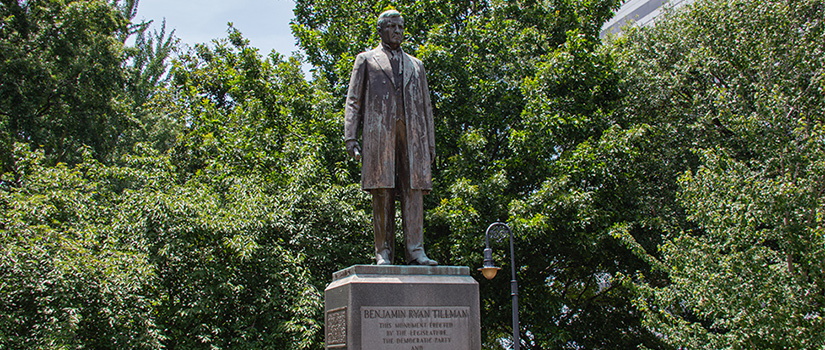June 23, 2020
Associate Professor of Art History Lydia Brandt, Ph.D., teaches courses on art and architectural history in the School of Visual Art and Design and is a specialist on the architecture of the South. She recently finished a year long project in partnership with Historic Columbia in which she created a guided tour of the monuments and architecture on the South Carolina State House grounds. Within the last month and in the context of the Black Lives Matter social justice movement, as people across the world have risen up against systemic and institutionalized racism, Professor Brandt spoke up about the need to remove Confederate monuments from public spaces from an historian’s point of view— and she isn’t the only historian calling for urgent action. On June 19, 2020, the Society of Architectural Historians, a nonprofit organization founded at Harvard University in 1940, issued their first ever statement actively calling for the removal of historic monuments, specifically Confederate memorials, from public areas, stating that "Confederate monuments do not serve as catalysts for a cleansing public conversation, but rather express white supremacy and dominance, causing discomfort and distress to African-American citizens who utilize the public spaces these monuments occupy. Our inaction gives these monuments power. By leaving them in place, we allow the dead hand of the past to direct some Americans away from that which belongs to all of us. History has proven that progress is possible, but also that the persistent racial schism in our society will not be conquered without radical, sustained action. The removal of Confederate monuments is a necessary and important step in this process, and one that cannot wait any longer."
Professor Brandt was interviewed by news outlets in Columbia about what it means to allow monuments honoring Confederate leaders to stand on display for public commemoration. The statue of Benjamin Tillman was put on display in it's current location on the State House grounds in 1940. Professor Brandt notes that putting up a monument to an individual who pushed for laws denying African Americans the right to vote clearly reflected the viewpoint of the South Carolina law makers and individuals in office at the time. "'If you think about the moment that it was unveiled, it was the moment that the South Carolina NAACP is starting to form, it’s when African Americans in South Carolina are starting to push back publicly against Jim Crow, and it’s when the federal government is beginning to push back against Jim Crow,' Brandt tells Free Times. 'So, by erecting a statue of Ben Tillman, the man who really solidified not only the ideology of white supremacy, but also the laws that would lay the groundwork for Jim Crow in the 1895 [state] Constitution, they are celebrating all of that, and building that monument as an affront to the rise of black power.'"
Upon a closer look at the statue of Tillman, Brandt believes the rolled piece of paper in his hand represents the South Carolina Constitution, “which effectively barred African American men, and later women, from voting for decades. The monument’s inscription, which praises Tillman as a ‘leader of the common people,’ clearly meant the white farmers who formed his political base. His actions as governor—as an avowed white supremacist who called for accused black rapists to be lynched and regularly boasted of his participation in the 1876 Hamburg Massacre, where he claimed to have ‘shot negroes and stuffed ballot boxes’—marked the beginning of South Carolina’s Jim Crow era” (Historic Columbia).
The Free Times’ report, "Reconsidering Ben: With protests sparking debate, could Tillman’s statue come down at SC Statehouse?" details that the monument of Benjamin Tillman, a former S.C. Governor and U.S. Senator who stripped Black South Carolinians of civil rights following the Civil War, has been marked as a top priority for removal being pushed by S.C. Representative Seth Rose and S.C. House Minority Leader Todd Rutherford.
